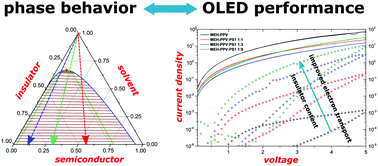Charge carrier trapping controlled by polymer blend phase dynamics
Abstract
It has recently been shown that diluting a semiconducting polymer with an insulating or large band gap host material can lead to elimination of charge trapping in the former. In this work we systematically study the role of the phase thermodynamics of such blends via tuning the miscibility between the semiconductor (here: MEH-PPV) and host (here: polystyrene or polyvinyl carbazole), by varying the molecular weight of the latter. We show that calculation of the ternary phase diagram of semiconductor, insulator and solvent can predict whether charge transport in the dry blend film will be trap-free or not. Blending MEH-PPV with 35 kg mol−1 polystyrene does not lead to alleviation of the trap-limited nature of the electron current due to strong segregation of the polymers and the formation of pure coexisting phases. In contrast, the electron current in miscible (1 kg mol−1 polystyrene) or partially miscible (30 kg mol−1 polyvinyl carbazole) blends increases by up to four orders of magnitude compared to the pristine semiconductor, together with a doubling in luminous efficiency of the corresponding light-emitting diode.



 Please wait while we load your content...
Please wait while we load your content...